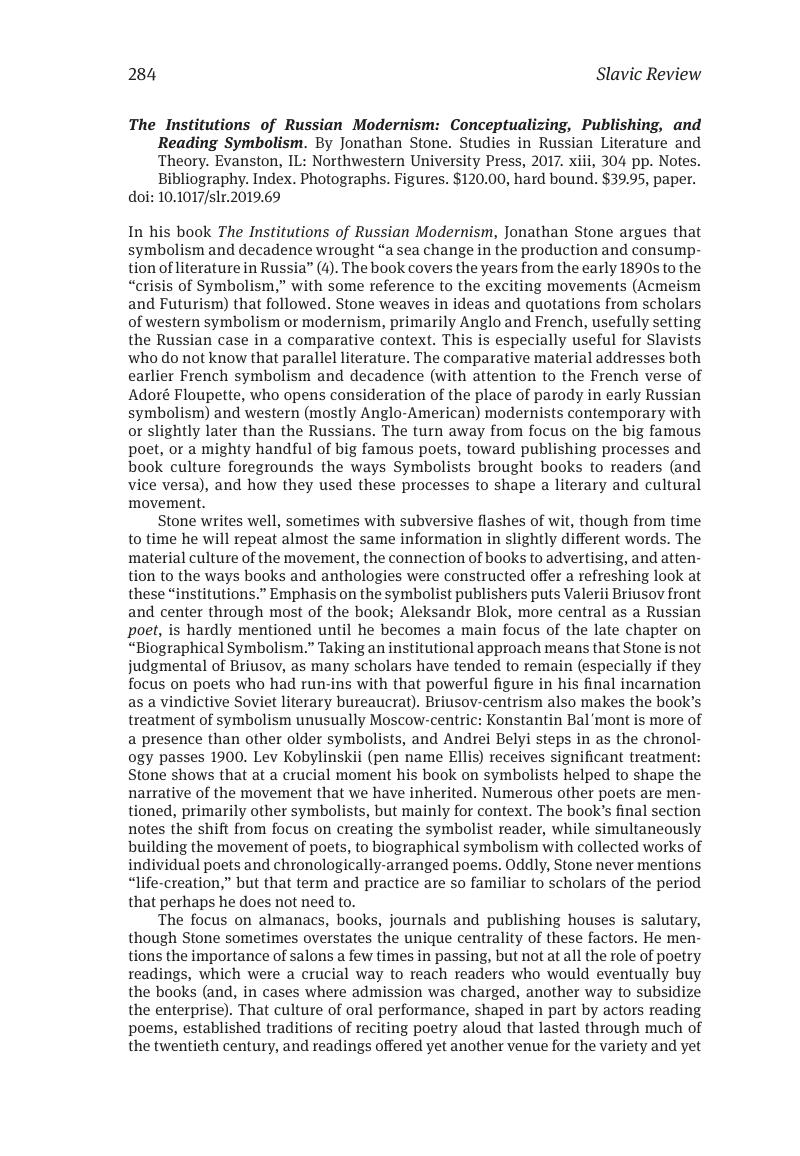In his book The Institutions of Russian Modernism, Jonathan Stone argues that symbolism and decadence wrought “a sea change in the production and consumption of literature in Russia” (4). The book covers the years from the early 1890s to the “crisis of Symbolism,” with some reference to the exciting movements (Acmeism and Futurism) that followed. Stone weaves in ideas and quotations from scholars of western symbolism or modernism, primarily Anglo and French, usefully setting the Russian case in a comparative context. This is especially useful for Slavists who do not know that parallel literature. The comparative material addresses both earlier French symbolism and decadence (with attention to the French verse of Adoré Floupette, who opens consideration of the place of parody in early Russian symbolism) and western (mostly Anglo-American) modernists contemporary with or slightly later than the Russians. The turn away from focus on the big famous poet, or a mighty handful of big famous poets, toward publishing processes and book culture foregrounds the ways Symbolists brought books to readers (and vice versa), and how they used these processes to shape a literary and cultural movement.
Stone writes well, sometimes with subversive flashes of wit, though from time to time he will repeat almost the same information in slightly different words. The material culture of the movement, the connection of books to advertising, and attention to the ways books and anthologies were constructed offer a refreshing look at these “institutions.” Emphasis on the symbolist publishers puts Valerii Briusov front and center through most of the book; Aleksandr Blok, more central as a Russian poet, is hardly mentioned until he becomes a main focus of the late chapter on “Biographical Symbolism.” Taking an institutional approach means that Stone is not judgmental of Briusov, as many scholars have tended to remain (especially if they focus on poets who had run-ins with that powerful figure in his final incarnation as a vindictive Soviet literary bureaucrat). Briusov-centrism also makes the book's treatment of symbolism unusually Moscow-centric: Konstantin Bal΄mont is more of a presence than other older symbolists, and Andrei Belyi steps in as the chronology passes 1900. Lev Kobylinskii (pen name Ellis) receives significant treatment: Stone shows that at a crucial moment his book on symbolists helped to shape the narrative of the movement that we have inherited. Numerous other poets are mentioned, primarily other symbolists, but mainly for context. The book's final section notes the shift from focus on creating the symbolist reader, while simultaneously building the movement of poets, to biographical symbolism with collected works of individual poets and chronologically-arranged poems. Oddly, Stone never mentions “life-creation,” but that term and practice are so familiar to scholars of the period that perhaps he does not need to.
The focus on almanacs, books, journals and publishing houses is salutary, though Stone sometimes overstates the unique centrality of these factors. He mentions the importance of salons a few times in passing, but not at all the role of poetry readings, which were a crucial way to reach readers who would eventually buy the books (and, in cases where admission was charged, another way to subsidize the enterprise). That culture of oral performance, shaped in part by actors reading poems, established traditions of reciting poetry aloud that lasted through much of the twentieth century, and readings offered yet another venue for the variety and yet overall common purpose of symbolism to be demonstrated. Group readings were also successfully picked up by the Futurists, whose performative debt to symbolism Stone notes. Unfortunately, there are a few issues in translations of the poetry cited, though the examples are well chosen and thoughtfully analyzed, along with their role as elements of larger interactive wholes.
The book is enhanced by a number of black and white illustrations, as accompanying text explains the original colors. Taking up the frames of the symbolist book, the carefully cultivated symbolist reader, and the symbolist publishing house, The Institutions of Russian Modernism is a valuable study of the topic. Stone foregrounds elements of poetic activity that have often not been central in the education of poetry scholars and offers a new angle from which to approach the canon of Russian Modernism.



